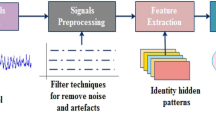Abstract
Stress is a natural human response to external conditions which have been studied for a long time. Since prolonged periods of stress can cause health deterioration, it is important for researchers to understand and improve its detection. This paper uses neural network techniques to classify whether an individual is stressed, based on signals from an electroencephalogram (EEG), a popular physiological sensor. We also overcome two prominent limitations of neural networks: low interpretability due to the complex nature of architectures, and hindrance to performance due to high data dimensionality. We resolve the first limitation with sensitivity analysis-based rule extraction, while the second limitation is addressed by feature selection via a genetic algorithm. Using summary statistics from the EEG, a simple Artificial Neural Network (ANN) is able to achieve 93.8% accuracy. The rules extracted are able to explain the ANN’s behaviour to a good degree and thus improve interpretability. Adding feature selection with a genetic algorithm improves average accuracy achieved by the ANN to 95.4%.
Access this chapter
Tax calculation will be finalised at checkout
Purchases are for personal use only
Similar content being viewed by others
References
Rahman, J., Gedeon, T., Caldwell, S., Jones, R., Jin, Z.: Towards effective music therapy for mental health care using machine learning tools: human affective reasoning and music genres. J. Artif. Intell. Soft Comput. Res. 11(1), 5–20 (2020)
Irani, R., Nasrollahi, K., Dhall, A., Moeslund, T., Gedeon, T.: Thermal super-pixels for bimodal stress recognition. In: Sixth International Conference on Image Processing Theory, Tools and Applications (IPTA), Oulu, Finland, pp. 1–6 (2016)
Lupien, S., Maheu, F., Tu, M., Fiocco, A., Schramek, T.: The effects of stress and stress hormones on human cognition: implications for the field of brain and cognition. Brain Cogn. 65(3), 209–237 (2007)
Saeed, S., Anwar, S., Khalid, H., Majid, M., Bagci, U.: EEG based classification of long-term stress using psychological labeling. Sensors (Basel, Switzerland) 20(7), 1886 (2020)
Gedeon, T., Turner, H.: Explaining student grades predicted by a neural network. In: Proceedings of 1993 International Conference on Neural Networks (IJCNN-93-Nagoya, Japan), Nagoya, Japan, vol. 1, pp. 609–612 (1993)
Hailesilassie, T.: Rule extraction algorithm for deep neural networks: a review. Int. J. Comput. Sci. Inf. Secur. (IJCSIS) 14(7), 371–381 (2016)
Mira, J., Sánchez-Andrés, J.V. (eds.): IWANN 1999. LNCS, vol. 1607. Springer, Heidelberg (1999). https://doi.org/10.1007/BFb0100465
Chawla, N., Japkowicz, N., Kotcz, A.: Editorial: special issue on learning from imbalanced data sets. SIGKDD Explor. Newsl. 6, 1–6 (2004)
Erguzel, T., Ozekes, S., Tan, O., Gultekin, S.: Feature selection and classification of electroencephalographic signals: an artificial neural network and genetic algorithm based approach. Clin. EEG Neurosci. 46, 321–326 (2014). https://doi.org/10.1177/1550059414523764
Babatunde, O., Armstrong, L., Leng, J., Diepeveen, D.: A genetic algorithm-based feature selection. Int. J. Electron. Commun. Comput. Eng. 5, 889–905 (2014)
Gomez, F., Quesada, A., Lopez, R.: Genetic algorithms for feature selection. Neural Designer Data Science and Machine Learning Blog. https://www.neuraldesigner.com/blog/genetic_algorithms_for_feature_selection. Accessed 21 June 2021
Kalas, M., Momin, B.: Stress detection and reduction using EEG signals. In: International Conference on Electrical, Electronics, and Optimization Techniques (ICEEOT), pp. 471–475 (2016). https://doi.org/10.1109/ICEEOT.2016.7755604
Author information
Authors and Affiliations
Corresponding author
Editor information
Editors and Affiliations
Rights and permissions
Copyright information
© 2021 Springer Nature Switzerland AG
About this paper
Cite this paper
Pan, E., Rahman, J.S. (2021). Stress Recognition with EEG Signals Using Explainable Neural Networks and a Genetic Algorithm for Feature Selection. In: Mantoro, T., Lee, M., Ayu, M.A., Wong, K.W., Hidayanto, A.N. (eds) Neural Information Processing. ICONIP 2021. Communications in Computer and Information Science, vol 1517. Springer, Cham. https://doi.org/10.1007/978-3-030-92310-5_16
Download citation
DOI: https://doi.org/10.1007/978-3-030-92310-5_16
Published:
Publisher Name: Springer, Cham
Print ISBN: 978-3-030-92309-9
Online ISBN: 978-3-030-92310-5
eBook Packages: Computer ScienceComputer Science (R0)




